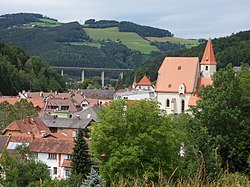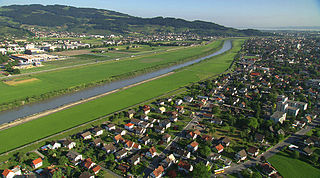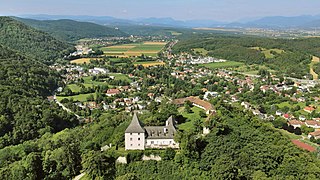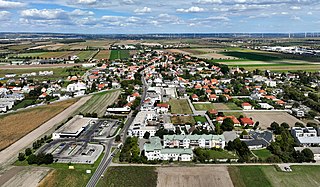Congregational Structure
The community forms the cadastral community Edlitz. This consists of Edlitz-Markt and the districts of Baumgart, Ebenhof, Grimmenstein, Grub, Handler, Hofstatt, Hofstetten, Kamerallen, Kohlreuth, Prägart, Pumperwaldl, Rauchlehen, Schafferhof, Schauerberg, Schneeweißhof, Sonnberg, Wieden and Winterhof.
History
Antiquity and the Middle Ages
The area used to be part of the Roman province of Noricum.
Due to the abundance of water in the Pittental and the associated frequent flooding, the first settlements in this area were difficult to access in the elevated side valleys. A find of Roman coins suggests that the transition area from the Edlitztal to the Pittental was already inhabited in Roman times. From the Middle Ages, the history of the place is very closely linked to the development of the church and the parish.
The parish seat "de Edelz" was first mentioned in 1192 CE, when it was separated from the mother parish of Bromberg and an independent parish was set up.
Late Medieval Ages and Early Modern Era (Incursions by Hungarians, Turks and Kurucs)
In the following centuries, Edlitz was hit by numerous Hungarian and later Turkish invasions. Several epidemics occurred. In the year 1349 CE, a separate plague cemetery had to be built for the many dead.
In 1529 CE, Edlitz escaped a Turkish attack when the Turks approached the area, but were startled by the midday ringing of the bells and turned back.
In 1590 CE, Edlitz was first referred to as a market town, which then had 14 houses.
In 1608 CE, pastor Georg Hayden was kidnapped by Hungarian forces to Güns and only released after 6 weeks after paying a ransom of 200 guilders. As a thank you, he donated the frescoes in the chancel of the parish church.
There are two more reports of military raids in the Edlitz area, namely in 1620 CE by Hungarians and in 1707 CE by Kurucs (anti-Habsburg insurgents). The fortifications of the church were likely used as a hiding place at this time.
Modern period
At the end of the 18th century, Edlitz once played an important role in economic and transport life in the Bucklige Welt. A description of the country that was carried out by Emperor Joseph II wrote about the town of Edlitz at the time: "Ein mittelmäßig solid gebauter Markt in einem Graben, hat auch eine solide Kirche, mit Kirchhofmauern umgeben." ("A moderately solidly built market in a ditch also has a solid church surrounded by churchyard walls.") That a place was "solid" at that time referred to the fact it was built of stone.
The town was often hit by flooding from the Edlitzbach. In 1886 CE a person died in the flooding, the creek was secured by a torrent barrier.
Transport routes and tourism
The 19th century brought a significant improvement in traffic conditions, when Count Palffy had the equestrian bridge from Grimmenstein to Edlitz and further on via Thomasberg to Kirchschlag and Güns expanded into a country road in 1815 CE. Today the federal highway runs along this former Palffy-Straße.
In 1881 CE, the opening of the Aspangbahn brought a new era to the Bucklige Welt. Edlitz station was built outside the municipal boundaries because the building site in Grimmenstein, which was then called "Am Treitl", was cheaper. Today Edlitz-Grimmenstein station is in the municipality of Thomasberg.
The opening of the railway connection also meant the start of tourism in Edlitz. Primarily guests from Vienna liked to come to the Bucklige Welt for summer holidays. According to the Austrian address book in 1938 CE, there was a doctor, two bakers, a butcher, a hairdresser, five innkeepers, five grocers, a glazier, two cellulose factories, a master bricklayer, four millers, a mill construction company and two fruit and vegetable dealers in the market town of Edlitz, two boarding houses, three sawmills, two blacksmiths, three tailors and seven seamstresses, six cobblers, a soda water producer, two tobacconists, three carpenters, a watchmaker, a cattle dealer, a grocer, two wheelwrights, a dental technician, a master carpenter and some farmers are resident.
In 1972 CE there were a total of 32,000 overnight stays in Edlitz. Today, tourism is still an important economic factor for the community, but the number of overnight stays is nowhere near as high. In recent years, the main focus of the municipality has been on improving the infrastructure in the areas of road construction, water supply, canal, kindergarten, fire station and office building.
Culture
Edlitz Parish Church
Catholic parish church Edlitz houses a fortified churches in the Bucklige Welt. The origins of the church date back to the second half of the 12th century CE. Almost square in plan with four cross-vaulted bays supported in the middle by a pillar, the nave is the main building element. The bell tower almost disappears behind the high roof of the church. When the nave was rebuilt in 1492 CE, the sacred building was equipped with fortified structures. The fortifications are still there today: cast oriel, loopholes, upper fortification floor in the attic with block chamber, former cistern under the church floor. The last exterior renovation took place in 1978 CE, the interior of the church was last renovated in 1984 CE (interior renovation, exposure of various versions of stone ribs and painting, restoration of the high altar, pulpit, Stations of the Cross and saints) and 2003 CE (redesign of the chancel). In autumn 2005 CE the roof was re-covered. The Edlitz parish church has five bells, the oldest comes from Lazlo Raczko from 1518 CE, another from 1757 CE, all others were purchased in 1948 CE.
The parsonage formed a unit with the fortified churchyard. The oldest surviving part is characterized by a gate that allowed access independently from the churchyard. A small stone tablet set into the wall above the gate bears the year 1463 CE and the name Oswald in Latin letters. Around the church you can still find the remains of the former churchyard defence walls.
Economy
There were 36 non-agricultural workplaces in 2001, and 55 agricultural and forestry businesses according to the 1999 survey. According to the 2001 census, the number of people in work at the place of residence was 478. The employment rate in 2001 was 48.5 percent.
There are small deposits of lignite on both sides of the road from Edlitz to Krumbach, but these are not worth mining.
Education
Edlitz is home to a few educational facilities:
- Lower Austria state kindergarten Edlitz
- Elementary school
- Edlitz Middle school
- Music School Artes Iuventutis
Personalities
- Franz Koller, farmer and politician, member of the Austrian National Council and member of the Bundesrat
- Hermann Schützenhöfer, ÖVP state party chairman and governor of Styria
- Karl Pichelbauer, provost emeritus of Wiener Neustadt
- Fjodor Fjodorowitsch Tornau (Theodor von Tornau): The Russian lieutenant general and Baltic baron, who had been military attaché in Vienna for a long time, chose Edlitz as his retirement home and died here on January 4, 1890.
- Nikolaus Schmidhofer alias Holzknechtseppl (* December 6, 1794; † November 20, 1828 executed in Pinkafeld): The notorious leader of the Stradafüßler gang of robbers is often incorrectly referred to as a native Edlitzer, although he lived in 1794 in Tyrnau near Fronleiten, Vorder Tyrnau. According to tradition, he was later placed with a foster family in Edlitz. [4] [5]
Literature
Market community Edlitz (ed.): Edlitz – our home community. 2 vols., 1992
This page is based on this
Wikipedia article Text is available under the
CC BY-SA 4.0 license; additional terms may apply.
Images, videos and audio are available under their respective licenses.



















